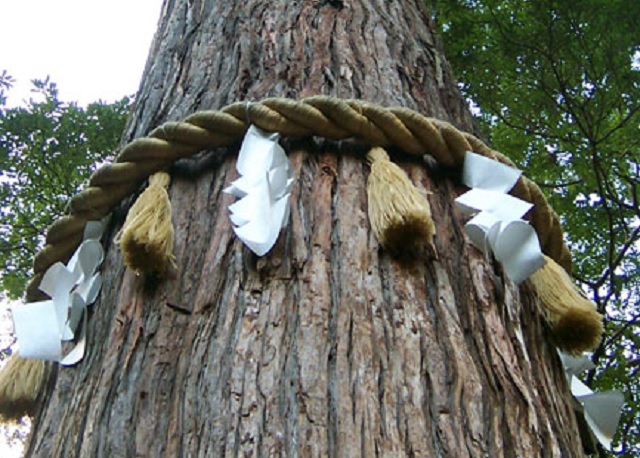
Shinmei Shrine’s sacred cedar saved the community twice, according to local legends.
One of the principal beliefs of Shinto is that divinity exists in the natural environment, and so on the grounds of many shrines in Japan you’ll find a shinboku, or sacred tree. The shinboku of Gifu’s Shinmei Shrine, however, was particularly special. Sadly, a powerful storm struck the shrine last Saturday night, and the shinboku, a towering cedar over 1,000 years old, has fallen.
▼ Shinmei Shrine’s shinboku following the storm
岐阜県瑞浪市にある「神明神社」で樹齢1000年を超えると言われる杉の木が根元から倒れ、家屋などに被害が出ています。県の天然記念物にも指定されていて、町のシンボルのような存在だったということです。https://t.co/3poQcp8Zim#nhk_news pic.twitter.com/EqVW5EvYkh
— NHKニュース (@nhk_news) July 12, 2020
40 meters (131 feet) tall and with a trunk 11 meters around at its thickest point, the tree’s most impressive bit of numerical data is its age, which is estimated at somewhere between 1,200 and 1,300 years. Then there are the legends surrounding the tree. According to the stories, long ago the community around the shrine was faced with a severe drought. Hoping for salvation, local villagers gathered and prayed at the shrine, and after seven days a white snake, a symbol of prosperity in Japanese folklore, briefly appeared, before slithering away into the earth at the base of the tree’s trunk. When the spot was examined, a spring of clean water was discovered,
▼ Shinmei Shrine’s shinboku, prior to the storm
瑞浪市、中山道大湫(おおくて)宿の神明神社のご神木。写真は昨年秋に撮影。このたびの倒木は残念ですね。 pic.twitter.com/mhHIlvTkfV
— KaneNobu (@y7BT45tIJRIp08J) July 12, 2020
The tree later became a symbol of the community when the area around the shrine developed into Okute-juku, one of the rest stops along the Nakasendo, one of the great roads connecting Tokyo with Kyoto during Japan’s samurai era.
▼ The shinboku stood atop the steps worshippers climb on their way to offer prayers.
But After the development of Okute-juku, once again the area faced a drought. Remembering the tale f the white snake, once again villagers gathered to pray at the tree, and this time it is said that a black snake appeared. Following this snake to a spot west of the tree, once again a spring was found, and this second source of clean water once again saved the community, allowing it to continue into the present day, when it’s known as the town of Mizunami.
瑞浪市大湫町にある、県の天然記念物の『大湫神明神社の大杉』が倒れたとか…。
— 190 (ikuo) (@shinkenger_red) July 12, 2020
この前見に行ったばかりなので本当にビックリしたしショック…。 pic.twitter.com/iameJw0Zwy
To this day, water could be drawn from the earth at the base of the tree. However, the water falling from the sky last Saturday proved to be too much for the shinboku. A nearby weather station recorded more than 1.3 meters (4.2 feet) of rainfall during the 24 hours between 8 a.m. on July 11 and July 12, and at around 10:40 p.m. on the 11th, a local resident reported that the tree had fallen, having overturned at the roots after the ground gave way.
https://twitter.com/Lakshmi_0401/status/1282535685837041665As it fell, the trunk damaged a shrine warehouse and gate and crushed the roof of a neighboring residence. Its top branches lay across a stretch of the road that runs in front of the shrine, blocking traffic until work crews came to clear it away the next morning.
岐阜県瑞浪市大湫町の「大湫神明神社」で、樹齢1200~1300年と推定され1956年に県の天然記念物に指定された神木が倒れました。前夜からの豪雨で地盤が緩み、倒木したとみられます。https://t.co/QBJtoMJl60 pic.twitter.com/YbCWNgUNQk
— 毎日新聞写真部 (@mainichiphoto) July 12, 2020
Thankfully, no injuries occurred, but the loss of the town’s symbol for the last millennium-plus still came as a shock to local residents. “It was the pride of our community, and we’re deeply saddened,” said a representative of the shrine, which has not yet said whether or not a replacement will be planted.
Source: NHK News Web via Jin, Gifu Shimbun, Mizunami City
Top image: Wikipedia/Melanom
● Want to hear about SoraNews24’s latest articles as soon as they’re published? Follow us on Facebook and Twitter!

 Japanese voodoo dolls with foreign politician photo keep getting nailed to town’s shrine trees
Japanese voodoo dolls with foreign politician photo keep getting nailed to town’s shrine trees Osaka shrine’s sacred horse provides no bathroom privacy, lots of laughs after “remodeling”【Vid】
Osaka shrine’s sacred horse provides no bathroom privacy, lots of laughs after “remodeling”【Vid】 Gigantic geyser erupts from Shinto shrine’s forest on the night before its summer festival【Video】
Gigantic geyser erupts from Shinto shrine’s forest on the night before its summer festival【Video】 Charges dropped against elderly Japanese man for nailing Putin voodoo doll to sacred shrine tree
Charges dropped against elderly Japanese man for nailing Putin voodoo doll to sacred shrine tree Japan has a “Totoro Tree” that looks just like the Studio Ghibli anime star【Photos】
Japan has a “Totoro Tree” that looks just like the Studio Ghibli anime star【Photos】 McDonald’s new Happy Meals offer up cute and practical Sanrio lifestyle goods
McDonald’s new Happy Meals offer up cute and practical Sanrio lifestyle goods All-you-can-drink Starbucks and amazing views part of Tokyo’s new 170 meter-high sky lounge
All-you-can-drink Starbucks and amazing views part of Tokyo’s new 170 meter-high sky lounge Studio Ghibli glasses cases let anime characters keep an eye on your spectacles
Studio Ghibli glasses cases let anime characters keep an eye on your spectacles Super Nintendo World expansion gets delayed for several months at Universal Studios Japan
Super Nintendo World expansion gets delayed for several months at Universal Studios Japan McDonald’s Japan releases a pancake pie for new retro kissaten coffeeshop series
McDonald’s Japan releases a pancake pie for new retro kissaten coffeeshop series Beautiful Sailor Moon manhole cover coasters being given out for free by Tokyo tourist center
Beautiful Sailor Moon manhole cover coasters being given out for free by Tokyo tourist center We try out “Chan Ramen”, an underground type of ramen popular in the ramen community
We try out “Chan Ramen”, an underground type of ramen popular in the ramen community More foreign tourists than ever before in history visited Japan last month
More foreign tourists than ever before in history visited Japan last month Last Samurai star Ken Watanabe cooks with daughter Anne in viral YouTube video
Last Samurai star Ken Watanabe cooks with daughter Anne in viral YouTube video The oldest tunnel in Japan is believed to be haunted, and strange things happen when we go there
The oldest tunnel in Japan is believed to be haunted, and strange things happen when we go there Disney princesses get official manga makeovers for Manga Princess Cafe opening in Tokyo
Disney princesses get official manga makeovers for Manga Princess Cafe opening in Tokyo Starbucks reopens at Shibuya Scramble Crossing with new look and design concept
Starbucks reopens at Shibuya Scramble Crossing with new look and design concept Beautiful new Final Fantasy T-shirt collection on the way from Uniqlo【Photos】
Beautiful new Final Fantasy T-shirt collection on the way from Uniqlo【Photos】 Is the new Shinkansen Train Desk ticket worth it?
Is the new Shinkansen Train Desk ticket worth it? Foreign English teachers in Japan pick their favorite Japanese-language phrases【Survey】
Foreign English teachers in Japan pick their favorite Japanese-language phrases【Survey】 Japanese convenience store packs a whole bento into an onigiri rice ball
Japanese convenience store packs a whole bento into an onigiri rice ball Studio Ghibli releases Kiki’s Delivery Service chocolate cake pouches in Japan
Studio Ghibli releases Kiki’s Delivery Service chocolate cake pouches in Japan Japan’s bone-breaking and record-breaking roller coaster is permanently shutting down
Japan’s bone-breaking and record-breaking roller coaster is permanently shutting down New definition of “Japanese whiskey” goes into effect to prevent fakes from fooling overseas buyers
New definition of “Japanese whiskey” goes into effect to prevent fakes from fooling overseas buyers Our Japanese reporter visits Costco in the U.S., finds super American and very Japanese things
Our Japanese reporter visits Costco in the U.S., finds super American and very Japanese things Studio Ghibli unveils Mother’s Day gift set that captures the love in My Neighbour Totoro
Studio Ghibli unveils Mother’s Day gift set that captures the love in My Neighbour Totoro Foreign passenger shoves conductor on one of the last full runs for Japan’s Thunderbird train
Foreign passenger shoves conductor on one of the last full runs for Japan’s Thunderbird train Domino’s Japan now sells…pizza ears?
Domino’s Japan now sells…pizza ears? New Japanese KitKat flavour stars Sanrio characters, including Hello Kitty
New Japanese KitKat flavour stars Sanrio characters, including Hello Kitty Kyoto creates new for-tourist buses to address overtourism with higher prices, faster rides
Kyoto creates new for-tourist buses to address overtourism with higher prices, faster rides Sales of Japan’s most convenient train ticket/shopping payment cards suspended indefinitely
Sales of Japan’s most convenient train ticket/shopping payment cards suspended indefinitely Sold-out Studio Ghibli desktop humidifiers are back so Totoro can help you through the dry season
Sold-out Studio Ghibli desktop humidifiers are back so Totoro can help you through the dry season Japanese government to make first change to romanization spelling rules since the 1950s
Japanese government to make first change to romanization spelling rules since the 1950s Ghibli founders Toshio Suzuki and Hayao Miyazaki contribute to Japanese whisky Totoro label design
Ghibli founders Toshio Suzuki and Hayao Miyazaki contribute to Japanese whisky Totoro label design Doraemon found buried at sea as scene from 1993 anime becomes real life【Photos】
Doraemon found buried at sea as scene from 1993 anime becomes real life【Photos】 Tokyo’s most famous Starbucks is closed
Tokyo’s most famous Starbucks is closed One Piece characters’ nationalities revealed, but fans have mixed opinions
One Piece characters’ nationalities revealed, but fans have mixed opinions We asked a Uniqlo employee what four things we should buy and their suggestions didn’t disappoint
We asked a Uniqlo employee what four things we should buy and their suggestions didn’t disappoint Princesses, fruits, and blacksmiths: Study reveals the 30 most unusual family names in Japan
Princesses, fruits, and blacksmiths: Study reveals the 30 most unusual family names in Japan TripAdvisor Japan announces the country’s 10 favorite shrines and temples
TripAdvisor Japan announces the country’s 10 favorite shrines and temples Japanese shrine creates special water fountain for thirsty bees
Japanese shrine creates special water fountain for thirsty bees At this Kyoto shrine, be careful what you wish for—and how—, because you just might get it
At this Kyoto shrine, be careful what you wish for—and how—, because you just might get it We try a delicious hidden gem in Fukuoka, unknown to even Japanese people
We try a delicious hidden gem in Fukuoka, unknown to even Japanese people A tree in India is bigger than the average Wal-Mart
A tree in India is bigger than the average Wal-Mart Huge torii gate found in the middle of a busy Kumamoto intersection
Huge torii gate found in the middle of a busy Kumamoto intersection Travel around Japan with stunning videos from the 4K ultra HD video library
Travel around Japan with stunning videos from the 4K ultra HD video library “Cat shrine” status causing problems for Japan’s millennium-old Izumoiwai Shrine
“Cat shrine” status causing problems for Japan’s millennium-old Izumoiwai Shrine Hanazono Jinja Shrine: Lanterns, stalls and rakes at annual Tori no Ichi cock festival in Tokyo
Hanazono Jinja Shrine: Lanterns, stalls and rakes at annual Tori no Ichi cock festival in Tokyo Tradition meets summer blooms as shrines arrange beautiful floating flower displays【Pics, Video】
Tradition meets summer blooms as shrines arrange beautiful floating flower displays【Pics, Video】 Japanese water purification ritual at shrines under threat due to the pandemic
Japanese water purification ritual at shrines under threat due to the pandemic Akihabara’s otaku shrine celebrates PlayStation 5 launch with ethereal one-night event
Akihabara’s otaku shrine celebrates PlayStation 5 launch with ethereal one-night event Tokyo’s 400-year-old Shinto shrine welcomes Roombas to help with annual susuosame ceremony【Video】
Tokyo’s 400-year-old Shinto shrine welcomes Roombas to help with annual susuosame ceremony【Video】 Visiting a maximum security shrine at the foot of the Narita airport runway
Visiting a maximum security shrine at the foot of the Narita airport runway Japanese anime fans shocked by torii gate collapse at Washinomiya aka the Lucky Star Shrine
Japanese anime fans shocked by torii gate collapse at Washinomiya aka the Lucky Star Shrine Petition to protest bulldozing of Ghibli-featured shrine gathers over 10,000 signatures worldwide
Petition to protest bulldozing of Ghibli-featured shrine gathers over 10,000 signatures worldwide
Leave a Reply